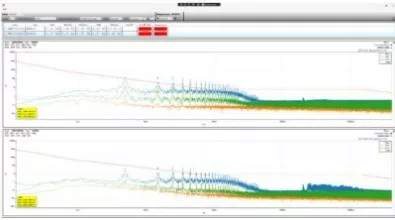

EMF Railway Test and Measurement
For city dwellers like us, whether commuting to work or exploring the city with family on weekends, the subway has become an indispensable part of daily life. However, both passengers and workers may be exposed to electromagnetic fields (EMF) in the rail transit environment at levels higher than those found in other places of our normal daily lives..
Assessing EMF levels have become important for avoiding excessive exposure of radiation to passengers, ensuring it to remain below established maximum limits. Various international organizations or countries have established relevant standards, such as ICNIRP 1998/2010/2020, IEEE C95, and China's GB8702-2014, which specify the requirements for EMF radiation limits relative to human beings in the range of 0-300 GHz to ensure human health.

Railway EMF Reference Standards
- EN 50500:2008/A1:2015 “Measurement procedures of magnetic field levels generated by electronic and electrical apparatus in the railway environment with respect to human exposure”
- IEC 62597:2019 “Measurement procedures of magnetic field levels generated by electronic and electrical apparatus in the railway environment with respect to human exposure”
- Chinese Standard GB/T 32577-2016
- TB/T 3351-2014
Testing Requirements Summary
- Test frequency range:
0-20kHz (mainly including locomotives, traction power supply equipment, and signaling equipment, but signaling equipment is generally ignored due to its relatively low power) - Measurement field:
DC/AC magnetic field (within 20kHz, magnetic field is dominant) - Test limit reference:
ICNIRP, IEEE (different testing standards) - Test locations:
- Rolling stock:interior and exterior measurements
- Fixed installation:measurements of fixed installation devices and worst-case scenarios (maximum possible current in bridges, level crossings, contact networks etc.)
- Measurement equipment:
- supports three-axis co-directional probe for DC magnetic fields
- supports three-axis co-directional probe with a frequency range of 5Hz-20kHz and an area of 100cm2
- spatial measurements
- data recording, etc.


EMF Sources and Measurement Locations for Railway
01of the rolling stock:Area accessible by workers
- Measurement Location:
Measurements should be taken near the sources of emission (for example, power converters, power cables and power inductors) in places where workers habitually carry out their duties - Measurement heights:
0.9 m and 1.5 m above the ground - Horizontal measuring distance:
The measuring distance to the walls should be 0.3 m or the minimum distance (>0.3 m)

02Interior of the rolling stock:Area accessible by public
- Measurement Location:
Measurements should be carried out in the closest possible position to the emission sources of the train (for example, power converters, power cables and power inductors) where the public may find themselves - Measurement heights:
0.3 m, 0.9 m and 1.5 m above the ground - Horizontal measuring distance:
The measurement distance to the walls should be 0.3 m or the minimum distance (>0.3 m)

03Exterior of the rolling stock
- Measurement Location:
Measurements should be performed in the closest possible position to the emission sources of the train (for example, power converters, power cables and power inductors). Measurements for the general public should not be performed at the same side of the third rail with respect to the tracks. - Measurement heights:
at 0.5 m, 1.5 m and 2.5 m height from the top of the running rails - Horizontal measuring distance:
0.3 m


04Fixed Installation: Open railway routes (public and workers)
- Measurement heights:
1.5 m above the ground (understood as the place where the public may stand) - Horizontal measuring distance:
Main line:10m (for general public)
Urban transport:3m (for general public)
Trams, trolley buses, Level crossings, Bridges, Underpass: 0m

05Fixed Installation: Areas close to fixed power supply installations (public and workers)
- Measurement Location:
Measurements should be performed at the closest possible position, where public or workers may be, to the emission sources from fixed power supply installations such as substations. - Measurement heights:
0.3 m, 0.9 m and 1.5 m from all public areas at 0.9 m and 1.5 m for areas exclusively for workers - Horizontal measuring distance:
horizontal measuring distance to walls or fences is 0.3 m or the minimum distance (>0.3 m)

06Fixed Installation: Platforms (Public and workers)
- Measurement heights:
0.9 m and 1.5 m above the platform level at 0.9 m and 1.5 m for areas exclusively for workers - Horizontal measuring distance:
0.3 m from the edge of the platform

EMF Sources and Measurement Locations for vehicles
In recent years, the main standard for vehicle electromagnetic field measurement is GB/T 37130-2018
- Measurement frequency range: 10Hz - 400kHz
- Test locations: mainly focused on 7 points of the seat, including the center of the headrest, backrest, seat cushion,
and foot space area. In addition, the center console position and the charging interface area of new energy vehicles are also tested. - Measurement equipment: isotropic magnetic field probe with an outer diameter not exceeding 13cm.
The risk of electromagnetic radiation in rail transit and vehicles has been successfully eliminated through the implementation of EMF safety standards. As the proverb goes, "a good workman always sharpens his tools.", it is crucial to select high-quality measuring instruments for precise measurements.
Frequency resolution requirements:
| Frequencyrange | Frequencyresolution |
|---|---|
| 10Hz ≤ f ≤ 5kHz | ≤ 1kHz |
| 5kHz ≤ f ≤ 50kHz | ≤ 5kHz |
| 50kHz≤ f ≤ 400kHz | ≤ 10kHz |
Wavecontrol SMP3 Electromagnetic Field Meter
The perfect equipment recommendation from ETS



3 INSTRUMENTS IN 1
Static field measurement, Spectrum analysis & Broadband field meter
EMF WORKER'S SAFETY
ICNIRP, EU Directive, FCC, SC6 (2015)
BROADBAND MEASUREMENT
0 Hz - 60 GHz
FFT-BASED TIME-DOMAIN SPECTRUM ANALYSIS
From 1 Hz to 10 MHz
DIGITAL OUTPUT
For real time external measurements
Ready for 5G measurements

Details of SMP3 and each probe
The frequency ranges and measurement details of SMP3 and each probe are as shown on the left.
The frequency ranges of SMP3 compatible field probe are as follows:

Railway Electromagnetic Field (EMF) Measurement Guide
Test 1: DC Static magnetic field measurement with a frequency range of 0-20kHz
Test 2: AC magnetic fields in an area of 100cm²

- SMP3 EMF meter
- WPH-DC probe (DC – 40 kHz)
probe dynamic menu selecting DC/DC-AC/AC (left)
probe dynamic menu selecting units related to H field (middle)
Final results seeing the maximum and minimum values (right)


- SMP3 EMF meter
- WP400 probe (1 Hz – 400 kHz)

The SMP3 field meter provides the most advanced features and technology on the market, designed for users who need high-quality measurements, ease of use and good reporting tools.”
Vehicle electromagnetic field (EMF) measurement guide
According to GB/T 37130 or other standards, electromagnetic field testing can be performed on vehicles with single or multiple points to be selected for testing.
1. Single point testing:
🗸 SMP3
🗸 WP400C probe (1-400kHz, supporting standards include GB8702-2014 and ICNIRP)
🗸 5m/10m probe extension cable (for remote operation)
🗸 Wavecontrol Streamer real-time testing software (with a frequency resolution of 1Hz). Test results can be exported in real-time.

2. Multiple points simultaneous testing:
Up to 7 points on the vehicle seats can be tested simultaneously, which saves time by avoiding point-by-point testing. It also enables real-time exporting of time-domain and frequency-domain test results for all points.
🗸 SMP3
🗸 WP400C7
🗸 2m/5m extension cable*7
🗸 Wavecontrol Streamer software








